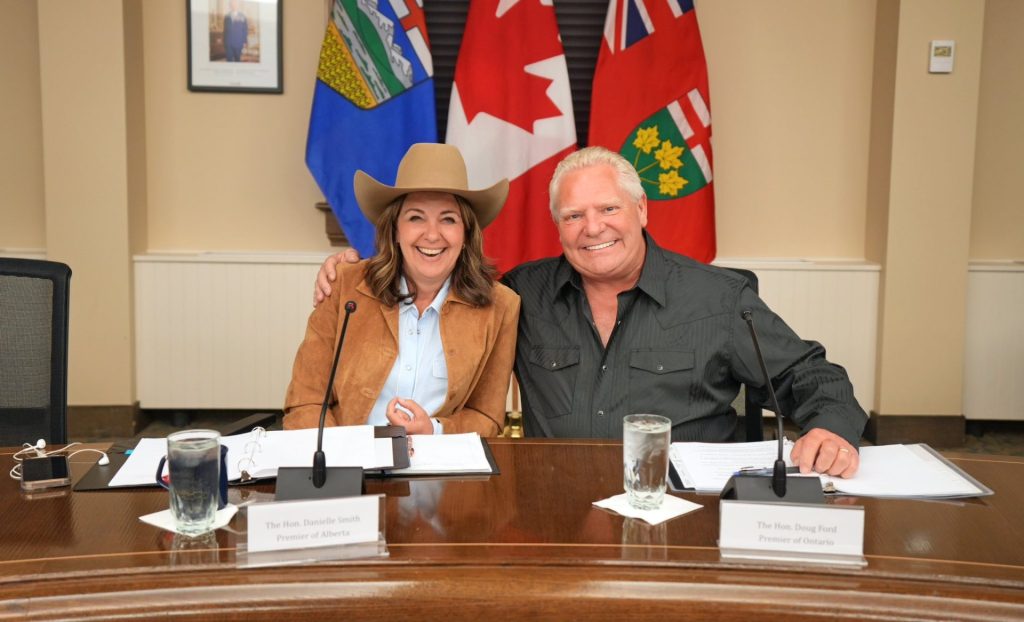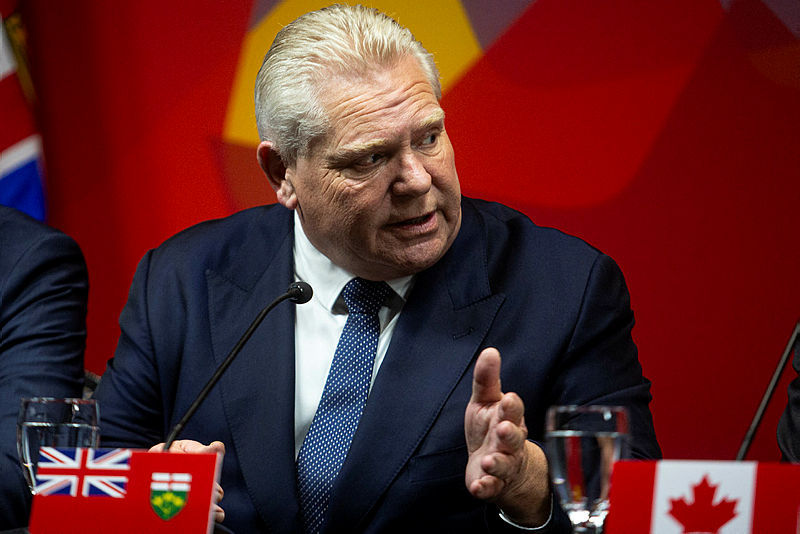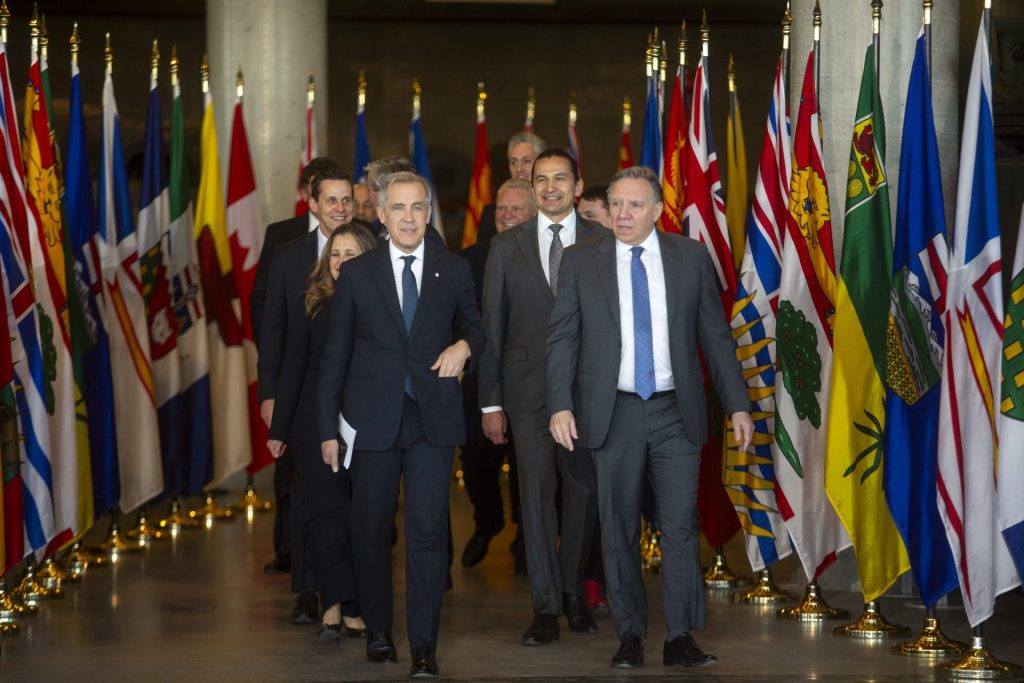The federal government may have held up its end of the bargain in lowering federally-imposed trade barriers by Canada Day, but premiers are now scrambling to strike their own trade deals between provinces.
“It’s solving one patchwork with another patchwork,” internal trade expert Ryan Manucha said. “It would have been nice if the federal government said ‘here’s what we will do, we’ll be highly involved in the process, devising model legislation.”
Because the feds regularly broker trade deals with international partners, “they have capacity and bandwidth to lead,” he said, “and I think there is an appetite for them to be a stronger leader from the centre.”
But, he added, “we can’t let great be the enemy of good here.”
As a part of Bill C-5, the One Canadian Economy Act, as of July 1 the federal government dropped 53 carveouts in the Canadian Free Trade Agreement (CFTA), which has been in place since 2017.
“The federal government will continue to show leadership in this area, and work with provinces and territories to strengthen the CFTA, advance mutual recognition, and ensure seamless labour mobility within Canada,” Transport and Internal Trade Minister Chrystia Freeland (University-Rosedale, Ont.) said in a June 30 statement.
Ontario has made trade deals with seven provinces and three territories, signing deals with British Columbia, Yukon, Northwest Territories, and Nunavut during the recent Council of Federations meeting in Huntsville, Ont., with the country’s premiers and Prime Minister Mark Carney (Nepean, Ont.).

Photograph courtesy of X
The summit’s agenda included discussing ongoing trade negotiations with the United States, efforts to protect Canada’s steel industry, the work to get major projects built, and the wildfires burning across the country.
Quebec is notably absent from a trade agreement with Ontario. The two provinces account for over half of the Canadian economy.
Several other provinces also signed bilateral agreements during the Hunstville meeting. Manitoba Premier Wab Kinew did not sign onto a trilateral trade agreement between Alberta, Saskatchewan, and Ontario, citing the need for consensus among Indigenous groups on major infrastructure projects.
The deals commit to reducing trade rules and regulatory standards for some employment actors between provinces.
As it stands, though, Ontarians can’t yet buy wine produced in Nova Scotia, for example.
“So we say ‘wait, what happened?’ What about all these declarations prior to Canada Day?” Manucha said. But, he said, mutual recognition legislation, where provinces recognize the professional credentials of a person certified in another province, was something of a pipe dream even six months ago.
“Never in a million years did you think it would happen at least this fast,” he said. “Every time there’s a win, I’m always saying, ‘what’s next?’”
Jean Philippe Fournier, vice-president with Teneo’s Strategy, said relations between Ottawa and the premiers have seemingly never been better.

“It’s safe to say relations are really good,” he said, citing Ontario Premier Doug Ford’s comments about Carney staying at his Muskoka cottage. Carney and Ford stayed up “’til 12:30 at night, chattin’ in front of the fireplace, solving all the world’s problems,” Ford told reporters.
Relations between Carney and the premiers have been positive since Carney became Liberal leader, and have only improved since the spring election, Fournier said. The feds are being “proactive” with their approach, but not setting out strict rules for the provinces to follow, he said, instead co-ordinating on mutual goals.
“The premiers are like, ‘okay, well, No. 1, I’m going to get money. No. 2, I’m going to build stuff. No. 3, I’m going to get credit for it. So what’s not to like here?’” he said.
“And that leads to late-night drinking, apparently.”
He noted Quebec seems to be the exception, but that’s par for the course for the province that’s “a bit of an ugly duckling” of the Confederation.
Quebec Premier François Legault did not seem to participate in the same type of cottage country hospitality as Ford, which isn’t surprising, Fournier said, but he suggested the public’s sentiment could be softening on that front.
“A lot of people even here in Quebec are like, ‘why can’t Legault have a beer at 11 p.m., too, with Carney?’”

Fournier said he’s not concerned about the “patchwork” approach to free trade deals struck between the provinces. Eventually, he said, so many provinces will have agreements that there will be de-facto recognition of credentials across the country, allowing the free flow of labour between provinces.
“I see it as a network effect,” he said. “Even if some provinces haven’t signed things, other agreements are in place.”
SeoRhin Yoo, a senior policy analyst of interprovincial affairs with the Canadian Federation of Independent Businesses, said the real test of progress is not how many memorandums of understanding (MOUs) get signed at the end of the day.
“It’s going to be whether these governments are going to be able to implement the agreements and help Canadians and Canadian businesses get to the place where they would like to see Canada be at,” she said.
The Canada-U.S. trade war, and President Donald Trump’s threats of making Canada a 51st state, have boosted Canadian businesses, she said, and over one-third of small- to medium-sized businesses report shifting their emphasis to domestic markets and suppliers.
“As more small businesses and consumers shift their sights to Canada’s domestic markets, now is definitely the time to accelerate efforts to remove internal trade barriers,” she said. “It feels like we have really great momentum from a lot of Canadian leaders. Hopefully it doesn’t just end with MOUs and agreements.”
Fournier agreed MOUs are only a work in progress, and don’t necessarily guarantee success. He noted Canada has struck many trade deals with other countries, but remains heavily dependent on America as a trade partner.
Internal trade has been thought to bring a $200-billion boost to the Canadian economy, but only if businesses take advantage of it.
“The ball will be in industry’s camp,” he said, “to get the full benefits of a more coherent and unified economy.”
The Hill Times
